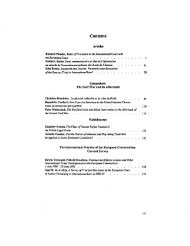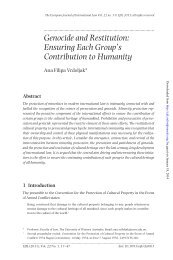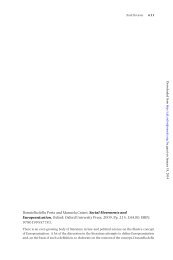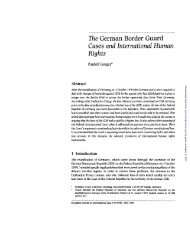Intangible Cultural Heritage - European Journal of International Law
Intangible Cultural Heritage - European Journal of International Law
Intangible Cultural Heritage - European Journal of International Law
Create successful ePaper yourself
Turn your PDF publications into a flip-book with our unique Google optimized e-Paper software.
<strong>Intangible</strong> <strong>Cultural</strong> <strong>Heritage</strong>: The Living Culture <strong>of</strong> Peoples 103<br />
colonization’, stressed that in her country they ‘have dozens <strong>of</strong> names for snow and ice<br />
because it is important to the hunters to differentiate them, but many children today<br />
know only a few <strong>of</strong> these names’. 4 This example epitomizes a process widespread in<br />
and characteristic <strong>of</strong> our contemporary world, in the context <strong>of</strong> which the cultural<br />
archetypes and interests <strong>of</strong> dominant societies globalize, to the prejudice <strong>of</strong> minority<br />
cultures, leading to cultural hegemony and uniformity at the local, national, regional,<br />
and international level. Such a process will eventually lead to the crystallization <strong>of</strong><br />
uniform and stereotyped cultural models and to the contextual mortification <strong>of</strong> the<br />
value <strong>of</strong> cultural diversity.<br />
In synthesis, the rich cultural variety <strong>of</strong> humanity is progressively and dangerously<br />
tending towards uniformity. In cultural terms, uniformity means not only loss <strong>of</strong> cultural<br />
heritage – conceived as the totality <strong>of</strong> perceptible manifestations <strong>of</strong> the different<br />
human groups and communities that are exteriorized and put at the others’ disposal –<br />
but also standardization <strong>of</strong> the different peoples <strong>of</strong> the world and <strong>of</strong> their social and<br />
cultural identity into a few stereotyped ways <strong>of</strong> life, <strong>of</strong> thinking, and <strong>of</strong> perceiving<br />
the world. Diversity <strong>of</strong> cultures reflects diversity <strong>of</strong> peoples; this is particularly linked<br />
to ICH, because such a heritage represents the living expression <strong>of</strong> the idiosyncratic<br />
traits <strong>of</strong> the different communities. Preservation <strong>of</strong> cultural diversity, as emphasized<br />
by Article 1 <strong>of</strong> the UNESCO Universal Declaration on <strong>Cultural</strong> Diversity, 5 ‘is embodied<br />
in the uniqueness and plurality <strong>of</strong> the identities <strong>of</strong> the groups and societies making<br />
up humankind’. Being a ‘source <strong>of</strong> exchange, innovation and creativity’, cultural<br />
diversity is vital to humanity and is inextricably linked to the safeguarding <strong>of</strong> ICH.<br />
Mutual recognition and respect for cultural diversity – and, a fortiori, appropriate safeguarding<br />
<strong>of</strong> the ICH <strong>of</strong> the diverse peoples making up the world – is essential for promoting<br />
harmony in intercultural relations, through fostering better appreciation and<br />
understanding <strong>of</strong> the differences between human communities.<br />
2 The Evolution <strong>of</strong> the <strong>International</strong> Safeguarding <strong>of</strong><br />
<strong>Intangible</strong> <strong>Cultural</strong> <strong>Heritage</strong><br />
As previously noted, at first the affirmation <strong>of</strong> the Western-rooted idea <strong>of</strong> cultural<br />
heritage – conceived as embodied in the material products <strong>of</strong> arts and architecture –<br />
prevented the immaterial portion <strong>of</strong> culture from emerging as an interest belonging<br />
to international law. This notwithstanding, since the early 1970s part <strong>of</strong> the international<br />
community has been aware that the scope and meaning <strong>of</strong> culture go beyond<br />
its mere tangible products, and that appropriate safeguarding is to be devoted<br />
Downloaded from http://ejil.oxfordjournals.org/ by guest on January 18, 2014<br />
4<br />
See <strong>International</strong> Conference, ‘Globalization and <strong>Intangible</strong> <strong>Cultural</strong> <strong>Heritage</strong>’, Tokyo, Japan, 24–26 August<br />
2004, available at: http://unesdoc.unesco.org/images/0014/001400/140090e.pdf (last accessed<br />
6 Oct. 2010), at 49, 51.<br />
5<br />
Adopted by the UNESCO General Conference on 2 Nov. 2001. The text <strong>of</strong> the Declaration is available at:<br />
http://portal.unesco.org/en/ev.php-URL_ID=13179&URL_DO=DO_TOPIC&URL_SECTION=201.html<br />
(last accessed 6 Oct. 2010).








